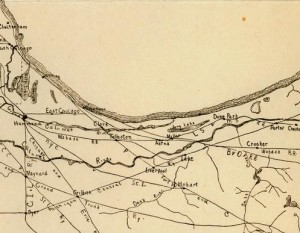There are many times when I give thanks for having the wonderful job of being a professor — and today is one such day. I’m writing this update from a motel room in Chesterton, Indiana, where I’m attending a writer’s/artist’s conference (with my two children in tow) sponsored by the Center for Humans and Nature, an environmental humanities organization which is leading the development of a book project / art exhibit scheduled for 2014 entitled City Creatures.
As a contributing author to this project, I’m lucky enough to be a part of this retreat to the amazing and inspiring landscape of the Indiana Dunes National Lakeshore, one of the most ecologically significant places in the Midwest and the closest national parkland to Chicago. Our goal is to think of ways in which humans relate to, connect with, and/or learn from non-human animals in the Chicago metro region — precisely the kind of “urban nature” questions my students and I have been grappling with the first two weeks of our summer humanities seminar on “Representations of the Urban Landscape.” Talk about a happy coincidence of timing!
 Yesterday afternoon, before taking a leisurely hike in the Calumet River marshlands of the Dunes, I heard a remarkable presentation by Ron Engel, a theologian, social activist, writer, and conservationist who lives in the Dunes community of Beverly Shores with his wife, Joan — herself a gifted writer and fellow conservationist. For four decades, Ron and Joan have dedicated themselves to protecting the Dunes from further industrial/commercial encroachment, advocated for their continued conservation and restoration, and documented their historical and cultural significance to the region. Ron is the author of the well-received book, Sacred Sands: The Struggle for Community in the Indiana Dunes (1983), which is sadly out of print but available at local libraries.
Yesterday afternoon, before taking a leisurely hike in the Calumet River marshlands of the Dunes, I heard a remarkable presentation by Ron Engel, a theologian, social activist, writer, and conservationist who lives in the Dunes community of Beverly Shores with his wife, Joan — herself a gifted writer and fellow conservationist. For four decades, Ron and Joan have dedicated themselves to protecting the Dunes from further industrial/commercial encroachment, advocated for their continued conservation and restoration, and documented their historical and cultural significance to the region. Ron is the author of the well-received book, Sacred Sands: The Struggle for Community in the Indiana Dunes (1983), which is sadly out of print but available at local libraries.
Today we gather again for a morning of discussion, brainstorming, and essay planning — the goal of which is to create a book and accompanying art exhibit that explores our human relationships with and connections to the non-human animals we encounter in a variety of urban settings within the Chicago Region: backyards, parklands, industrial sites, rivers and lake shoreline, etc. Then we’ll take another hike through the rich Dunes landscape to learn more about the complex cultural and natural history of this place — and how they are intricately intertwined.
It’s good to meet people this way — interacting, conversing, exploring . . . all with a common goal in mind. Yes, we could’ve planned and brainstormed this project solely by email and conference call. But I’m glad the project’s organizers, Gavin Van Horn and David Aftandilian, set up this retreat — a rare opportunity for many of us to take time out from our busy lives and collaborate face to face in a deep and meaningful way.
Next week — pictures from the retreat!